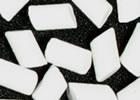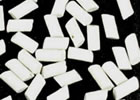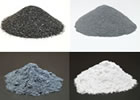Banded Amethyst - With Milky and Smoky Quartz
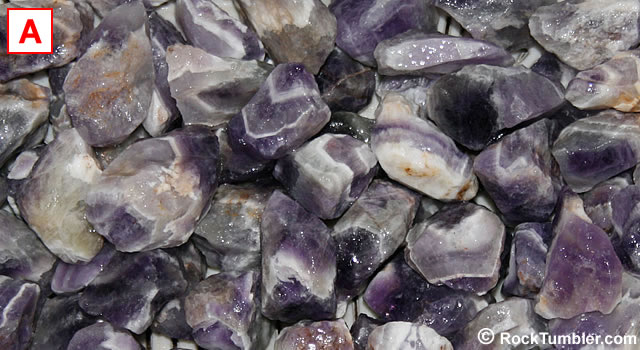
This image shows a bag of banded amethyst tumbling rough, dumped into a colander and sprayed with water to reveal its full color. Click on the image for a larger view. Wow!
Banded Amethyst Tumbling Rough
 ,
,  , and
, and  What do they mean?
What do they mean?
Size: mostly 1/2 to 2 inch pieces
We are selling two-pound bags of banded amethyst, specially sized for rock tumbling. Each bag contains mostly pieces that are between 1/2 to 2 inches in size. The exact size varies from bag to bag. There are usually about ten to twenty pieces per pound.
This material consists of beautiful purple amethyst, white milky quartz, and a small amount of gray smoky quartz. These three materials are banded with one another into beautiful patterns. A few pieces are zoned crystal fragments that when broken display the popular "V" shaped pattern known as "chevron amethyst." Look at the photo at the top of this page to see a few "chevrons." These make beautiful tumbled stones. Crafty people use tumbled stones of banded amethyst as attractive pendants, pocket stones, key chains, accents for potted plants, display gems for their homes and much more.
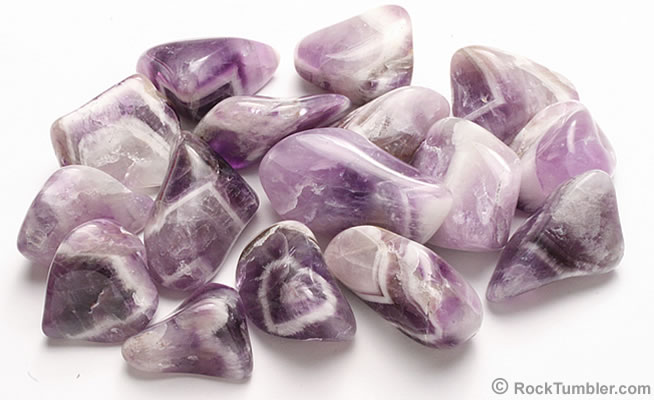
Here are some pieces of our rough banded amethyst that were tumbled using the Rock Tumbling Recipe below.
This banded amethyst is mined in Namibia, a country on the western coast of southern Africa. Namibia is a difficult place to live or explore for gems because much of it is covered by desert. It is one of the remaining parts of the world where a wide variety of semiprecious stones are still being found.
ADVANCED Rock Tumbling Recipe:
Banded Amethyst (1/2 to 2 inches)
As a crystalline variety of quartz, banded amethyst can be polished to a very high luster but many people who tumble it in pieces over about one inch in size experience a problem - tiny bruises around the edges of their tumbled stones. These bruises are caused by quartz-to-quartz impacts within the tumbler barrel. This problem is easy to solve by tumbling the quartz in a sea of ceramic cylinder media. The small particles of ceramic media smooth the tumbling action and isolate the pieces of quartz from impact with one another. The ceramic media absorbs much of the impact energy produced during the tumble. When tumbling the banded amethyst sold here, two things should be considered:
1) More Time: Crystalline quartz is hard and because of that it requires more time in the tumbler with coarse grit to produce nicely-shaped tumbled stones. For the rough that we are selling, in six-, twelve- and fifteen-pound capacity barrels, two to four weeks might be required to shape the rough nicely. In small tumblers of two or three pounds capacity, three or four weeks - or longer - can be needed. We suggest tumbling crystalline quartz in coarse grit for two weeks, clean the rough and the barrel, then run one or two more weeks in coarse grit - until you are happy with the shape. When you are happy with the shape, move on to medium grit.
2) Media Needed: You want crystalline quartz to be swimming in a sea of ceramic cylinder media. This is required if you want to avoid bruised tumbled stones. When we tumble crystalline quartz in coarse grit, we fill the barrel about a third of the way with ceramic cylinders and then add the quartz. That will give you a ratio of about 70% quartz and 30% ceramics. The cylindrical shape of the ceramic media will act like a roller bearing and give the rocks a smooth tumbling action in the barrel. The small pieces of media also deliver grit to all surfaces of the rough.
| Using Small-Size Rough Instead of Media: Some people use small pieces of rough instead of media. This can work well if your small rough meets two requirements: 1) the small pieces of rough must be blocky or rounded in shape to produce a good tumbling action - thin or flaky pieces will break up quickly and might not produce a smooth tumbling action; 2) the small pieces of rough must have a hardness that is equal to or greater than the rough that they are tumbled with - if they are softer they will tumble into mud before their job has been done. |
Recipe for Rotary Tumbling:
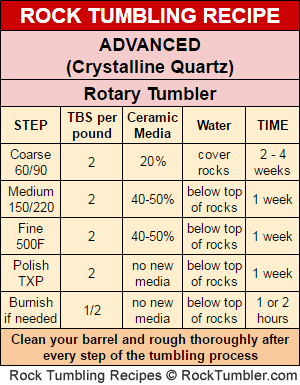
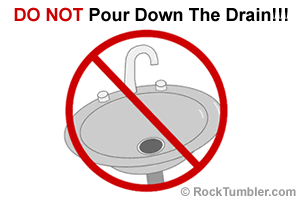
Barrel slurry dumped down the drain will harden like concrete.
Coarse Grit Step: Fill the barrel 2/3 full with a mix of 20% media and 80% banded amethyst. Add two level tablespoons of coarse grit per pound of material and cover the rocks completely with water. Then tumble for two to four weeks - or long enough to shape and smooth the stones.
Medium Grit and Fine Grit Steps: Again, fill the barrel 2/3 full. Your rough volume will have dropped because of loss during the coarse and medium grit steps. Add some additional media to bring the barrel up to proper level. This should get the media up to the suggested 40-50% of barrel capacity. Use two level tablespoons of grit per pound of material for each of these steps. Add enough water to almost cover the rocks and tumble for one week. Don't over-tumble at this step. If you allow the rocks to tumble more than is needed, you run the risk of bruising.
Polish Step: Be sure that the rocks, media, barrel and lid are extra clean. Also, make sure that the barrel is filled to the proper level. Add more media if needed, but if you have to add more media be sure it is clean POLISHED media. Dusty media or media that has not been broken in and smoothed can scratch up your tumbled stones at this step. We use two level tablespoons of TXP aluminum polish for each pound of rock. Add water until it almost covers the rocks, and tumble for one week.
Burnish If Needed: This material usually takes a great polish. However, burnishing it after the polish step can often improve the look of the stones. If you would like to try burnishing, full instructions can be found here.
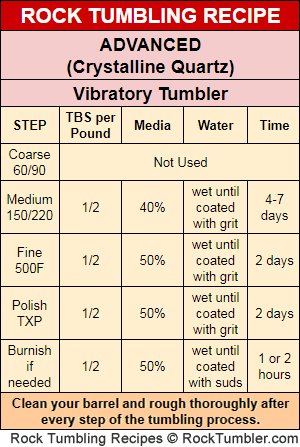
Vibratory Tumbler Recipe:
1/2" - 3" Crystalline Quartz rough
Coarse Grit (60/90 Mesh):
Coarse grit is not used in a vibrating rock tumbler.
Medium Grit (150/220 Mesh):
Crystalline quartz bruises easily around the edges. It is recommended that you start with a minimum of 40% ceramic media. The use of this media will aid in the tumbling action in the barrel and help deliver grit to all surfaces of the rough.
After you have your bowl loaded to the manufacturer's recommended level add 1 tablespoon of grit for every two pounds of material, including the media, in the bowl. While the tumbler is running, slowly add water until the material has a thin coat of wet grit and the tumbling action is smooth and fast in the bowl.
Check the bowl every 8-12 hours to ensure the action is still good. If the action has slowed, add water a little at a time until the action is back to normal. If the mud gets too thick you will need to do a complete rinse of the material and bowl. After rinsing, add fresh grit and water and start tumbling again. You are done with medium grit when you are satisfied with the shape and smoothness of the stones. Usually 4-7 days for us with this material. Give the material and bowl a thorough cleaning before moving on to fine grit.
Fine Grit (500F Mesh):
Place your material back in the tumbler bowl, then add enough polished ceramic media to bring the load up to the manufacturer's recommended operating level. This will also get you near the recommended 50% ceramic media for the polishing step. Add one tablespoon of grit for every two pounds of material in the bowl. Then, turn the tumbler on and slowly add water until the material has a thin coat of wet grit and the tumbling action is smooth and fast in the bowl.
Open the bowl every 8-12 hours to check that the action is still good. We usually run fine grit for 48 hours. Thoroughly clean the bowl and material before moving to the polishing step.
Polish (#61 Rapid Polish or TXP):
Place the cleaned material back in the bowl. If needed, add ceramic media that has been previously polished, to bring the bowl up to the manufacturer's recommended operating level. This media should be washed thoroughly before adding to prevent adding contaminant dust particles that might behave like grit in the polishing step. Add one tablespoon of polish for every two pounds of material in the bowl. Turn on the tumbler and slowly add water. Stop adding water when the material has a thin coat of wet polish and the tumbling action is smooth and rapid.
Like the previous grit steps, open the bowl every 8-12 hours to check the tumbling action. Add water if it has slowed. We have found that 48 hours is usually all the time you need to get a good polish in a vibratory tumbler. Any more time than that and you run the risk of damaging / bruising the material.
Burnish If Needed:
This rough will usually take a great polish. However, burnishing this material after the polish step can often improve the look of the finished stones. If you would like to try burnishing to see if it improves the look of your polished stones, full burnishing instructions can be found here.
What is Amethyst?
Amethyst is one of the top ten most popular gemstones across human history. It is found in many parts of the world and is abundant enough to be relatively inexpensive. People love its purple color. Few other gems compete with amethyst on purple color or on price.
Tumbled Banded Amethyst Available
We usually have medium-size (5/8" to 1") tumbled stones of banded amethyst for sale to anyone who would rather purchase finished stones than run a tumbler. You can find them here.
Customers also bought...
Large Ceramic Media

Small Ceramic Media

Standard Grit Kit



